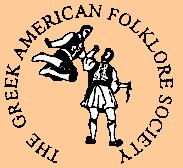Costumes: Dodecanese - Karpathos - Olymbos
/These costumes are still worn by the villagers and they represent significant stages of their life.
The sakofoustano (the first costume) is the unmarried woman's version. The girls from an early age dress in this for everyday or festive occasions. Originally, the preferred material was oriental silk, brocade with a busy floral design on it. Nowadays, they still use similar prints, and the same colors but they choose fabric with more freedom. The costume consists of a pleated skirt and vast ornamentation (about 25 centimeters wide) around the hem comprised of bright colored ribbons, rick-racks, and as we can see on the newer version, sequins. The blouse-like top is also heavily pleated on the front and the lower part of the back. The adornment on the bosom is very similar to that of the hem. The belt is sewn onto the blouse and also decorated. In time, the hand-crocheted lace has been replaced with manufactured lace and has come to border the hem. The apron is worn over the skirt, but underneath the blouse. The large white scarf, the mantili, which comprises the headpiece has a crocheted edge with sequins and small beads. It is tied in such a way that the floral design on it shows at all times.
The newly wed woman's costume is the same as the unmarried except that she also wears a black overcoat, thekavadi, and they trade in their white mantili for a black one. They are supposed to wear this for the first 40 days after the wedding, after which they take off their fancy, shinny sakofoustano and replace it with a simple, cotton chemise. In the opening of the chemise and around the neck and sleeves, they use a small cross-stitch rose embroidery.


